Protect the Frontier: Star Frontiers Roleplaying
When I think back all those years ago about visiting a Waldenbooks in the Terre Haute, Indiana mall, I can never firmly, confidently say whether I bought the boxed set of Star Frontiers or Traveller. My hunch is that it was Star Frontiers, the science-fiction role-playing game by TSR (the company that Dungeons & Dragons co-creator Gary Gygax founded with Don Kaye and Brian Blume) that came out in 1982 – really, a response to GDW’s Traveller, published in 1977. While Traveller, which I had shortly after Star Frontiers, if that’s the correct order, became a personal favorite from then on, Star Frontiers still conjures fond memories.
While the community for Traveller is thriving thanks to Marc Miller’s (the creator of the game and co-founder of GDW) smart decision to retain ownership of the game post-GDW, which has allowed multiple editions to be published over time, Star Frontiers does not have the benefit of official support since the line was ended by TSR in the 1980s. Hence, the game lives on only within a community of gamers who still play it, though they actively do so along with fanzines.
Gen Con has a session or two of it every year it seems, and the Facebook Group, Star Frontiers: Alive and Well, has 2,800 members. Indulging in a bit of nostalgia, I purchased a PDF and print-on-demand hard copy of the game, Star Frontiers: Alpha Dawn. This is a version of the original boxed set, including the Basic Game Rules book, Expanded Game Rules book, and the adventure, Crash on Volturnus.
Cracking open the Basic Game Rules, one is greeted by a short story illustrated with images in boxes reminiscent of comic books. Looking at those images, it was clear to me why the game would have enthralled the young version of myself. The illustrated short story captures the difference between Traveller and Star Frontiers.
While both are space opera, Traveller lies on the spectrum toward harder science fiction (i.e., more limited to realistic science insofar as we understand that to be), while Star Frontiers lies at the other end. This has always translated, at least for me, to Traveller being a bit more serious about the science in its science fiction while Star Frontiers went action-adventure in a science fiction universe. If I were to use 1980s film as analogies in regards to tone, Traveller was like Die Hard or First Blood, and Star Frontiers was the over-the-top action movies like Commando or Rambo III. The movies succeed (if you think so) in being entertaining but with a different flavor and tone — at least in how my games eventually came to be.
That said, as Scott Taylor noted in “Art of the Genre: Star Frontiers,” it is a “clean game”:
It’s like a perfect joining of Star Trek and Star Wars, where characters find themselves challenged to explore new worlds while still dealing with a handful of alien races as trusted friends.
Along with the Basic Game Rules, Expanded Game Rules, and an adventure, Crash on Volturnus. The original boxed set also included a map and cardboard counters and dice (two ten-sided dice) with a crayon to color in the numbers. That’s right. Back in the early days of role playing games, the dice you purchased often did not have colored numbers.

The rules even mention tell you what to do:
The crayon included with this game can be used to color in the numbers on the dice and make them easier to read. Simply rub the crayon over the sides of the die and wipe away the excess wax with a tissue or paper towel.
The setting for Star Frontiers is near the core of the galaxy. The humans in it are not humans from Earth but a separately evolved species. They eventually encountered three other friendly alien species: the amoeba-like Dralasites, the vaguely praying mantis-like Vrusk, and the combo flying squirrel-chimpanzee Yazirian. (Additional playable species were added a later book, Zebulon’s Guide to Frontier Space.)
As the civilizations expanded and grew together, they formed the Pan-Galactic Corporation to provide the supplies and raw materials to support the growth. When an alien menace, the Sathar, started attacking isolated systems, the Humans, Vrusk, Dralasites, and Yazirian formed the United Planetary Foundation (UPF) and eventually the Star Law Rangers to fight the menace.
The game mechanics are percentile based — i.e., need to do an action, roll two ten-sided dice. One acts as the tens and the other acts as the ones. If you roll the number under, you succeed. The Basic Game Rules are indeed basic — 16 pages. They provide mechanics for character creation, combat rules, some basic equipment, and a couple of adventures.
Star Frontiers pairs eight abilities into four aligned characteristics: Strength / Stamina, Dexterity / Reaction Speed, Intuition / Logic, and Personality / Leadership. These are given scores from 30-70 (in increments of five), which are subsequently modified by the species you choose. The humans get no adjustments. For example, Dralasites get a +5 to Strength / Stamina and a -5 to Dexterity / Reaction Speed. In the Basic Game Rules combat is highly tactical, with a significant focus on movement on a grid and sighting opponents. Damage is covered, along with healing. For severe injuries, one needs a hospital, which the rules describe thusly:
At the end of an adventure, characters that are still conscious can take themselves and any unconscious friends to the Medical Complex to be healed.
This highlights that the Basic Game Rules provide a board game experience. The two adventures at the end of the book are called “programed adventures”:
The story is written in a series of numbered paragraphs. The reader reads the first paragraph to the players, and then they are presented with several choices. All the players must agree on one choice. This choice will direct the reader to another numbered paragraph, which he then turns to and reads to the players. At some points the players will get into combat. and this must be played out before moving to the next event. The passages boxed in gray should not be read aloud; they are special instructions for the reader only.
The height of railroading, this seems to me very much a part of the early years of role-playing games and emerging from the roots of war gaming that they evolved from. The Basic Game Rules serve as a vehicle for introducing players to some of the concepts for role-playing while still restricting the players so as to avoid potential frustration (presumably). Once familiar with the basic rules, players were expected to move on to the Expanded Game Rules. It is in these rules where the more traditional rules for role-playing games reside. The Basic Game Rules are not so much overwritten as, well, expanded to all allow for free-form role-playing and conducting tasks beyond the programed adventure’s narrow set of activities.
The Expanded Game Rules start by digging into the various species in more detail, providing basic physical appearance, sense, societal structure, attitudes toward other species, and special abilities. Each one also includes anatomical illustrations. For example, the Yazirians have Battle Rage as a special ability, which gives them a +20 to hit in melee combat. Even the Sathars have a write up.
Is that Dralasite giving the Nixon victory sign?
The Sathars are the overarching nemesis in Star Frontiers. A species that appeared out of nowhere and engages in genocidal destruction. They remain an enigma, and are particularly dangerous for having hypnotic powers. One of the jobs of the Star Law Rangers is to uncover the servants of the Sathars (unwitting or not) and stop them from enacting their plans.
Walking Sathars are rather silly looking….
After the brief descriptions of the various species, the next section of the Expanded Game Rules covers skills, 13 of them. These are divided between three primary skill areas (PSA): Military, Biosocial, and Technological. Characters choose one of the primary skill areas as a “career.” Players choose two primary skills and one additional skill, and all are at Level 1. As characters earn experience points, additional skills or skill levels can be purchased. Those outside a character’s career are double the cost.
The skill sections are a tad bit confusing in their tally, specifically the Military PSA. In the summary of the Military skills, the rules state, “There are seven different Military skills: Beam Weapons, Demolitions, Gyrojet Weapons, Martial Arts, Melee Weapons, Projectile Weapons, and Thrown Weapons.” However, in the fuller description, Beam, Gyrojet, Melee, Projectile, and Thrown Weapons all appear under the larger heading of Weapons Skill — which looks like the same level as Demolitions or Martial Arts. This is additionally compounded by the fact that the other skills in the Biosocial and Technological PSAs have sub skills that seem on the same level as Beam, Gyrojet, and so on. The confusion is easy enough to overcome but needs to be accounted for.
Another sign of Star Frontiers being an early RPG is that the skills and sub skills do not work consistently. Over time, RPG designers learned that systems were easier to learn and quicker to play when the use of skills were consistent. For example, in Delta Green (another percentile based system), if you have an Occult skill of 20%, you roll 20 or under on the percentage dice to succeed. All other skills work the same: History, Persuade, Heavy Machinery. In contrast, the skills and sub skills in Star Frontiers each have their own rule to follow. Each skill level a character has represents 10% (i.e., a Level 2 Computers skill is 20% for purposes of rolling). These are then added to some other rule.
For example, if Hasner, my Dralasite computers expert, wants to use their Defeating Security sub skill to get into a Sathar agent’s computer, they calculate their chance of success by taking 60% plus Hasner’s Computer Skill level of 2 (so 20%) minus the program level (x10) of the computer security program. In this case, that is 3, so 30%: 60%+20%-30% = 50% chance. That is the roll Hasner’s player must roll under to succeed. However, the Manipulating Programs sub skill uses a different base percentage (50% instead of 60%). This is pervasive throughout the skills area and requires the player and referee to have the rules handy to re-check. That said, this is not unique to Star Frontiers. Traveller often had variant target numbers for any number of different tasks.
Both Movement and Combat (including vehicles) receive a much broader set of rules in the Expanded Game Rules that add complexity and interest, moving the game away from a board game to a more fleshed out RPG combat and movement system. These include different speeds for the species (Dralasites are slower than Vrusks), disarming opponents, and weightless combat. In response to more options around combat, damage — both being hurt and healing — have expanded write ups.
For the referee, a section devoted to creating creatures the characters may encounter provides guidance and rules along with a sampling. The referee determines the creature’s purpose, type (carnivore, herbivore, or omnivore), size, quantity (solo or herd), speed, and so on. Averages are provided to assist, and representative creatures on the planet Volturnus (the game’s included adventure) show a lack of naming inspiration: strangler chute, sand shark, funnel worm.
The Equipment section includes many weapons, toolkits, and other things along with rules for Computers and various software. Robots receive a write up in the equipment section and enable players to create them with a variety of appearances and purposes. Any science fiction RPG written in the 1970s (Traveller) and 1980s (Star Frontiers) shows their age in these sections. That said, Star Frontiers’ rules are general enough to not be completely ridiculous and allow for the retrofuturism feel of many of these classic science fiction gams.
The Frontier sector of space and traveling to and from those systems are discussed, along with customs, layovers, and other elements associated with airline travel today. High-level details on the planets include the population, major industries, exports, imports, gravity, length of day, and color of the system’s star. A few receive special note. For example,
Hentz (Araks) is ruled by a religious clan, the Family of One. Everyone and consider smuggling a serious crime. The planet has rings that are who lives there wears a uniform showing his job and position.
One of my favorite pieces of art from the early days of RPGs
A short section on how to be a referee with some random NPC reaction tables ends the core of the came. This section is rudimentary, but in the 1980s it served as a useful introduction to being a referee.
Star Frontiers, despite showing its age, remains a fun, playable role-playing game. Particularly with the Expanded Game Rules (and if you also use the starship rules from Knight Hawks) engaging in the swashbuckling, action-oriented universe of the Frontier worlds can be as rich and exciting as modern role-playing games. Indeed, the straightforward simplicity of much of the game would fit in with many gaming tables today.
For really interested players, you can also find two free excellent fanzines, Star Frontiersmen and Frontier Explorer, the latter of which is still active. These two fanzines expand on rules, add equipment, and so on. They are worthy additions and have helped to increase the options in the game for players and referees.
A page from the April 2020 issue of Frontier Explorer
Star Frontiers remains a playable and enjoyable game. A group of devoted fans have kept the game alive and expanded on it, so if you’re looking for an easy-to-learn RPG with a focus on action, give it a go. I think you may like the retrofuture it inhabits. Wizards of the Coast have released the substantial backlist of core rules, adventures, and supplements in digital format, which you can get from DriveThruRPG.com. Just watch out for the Sathar agents or the sand shark….
Patrick Kanouse encountered Traveller and Star Frontiers in the early 1980s, which he then subjected his brother to many games of. Outside of RPGs, he is a fiction writer, avid tabletop roleplaying game master, and new convert to war gaming. His last post for Black Gate was The Dark Corners of Cyberpunk 2020’s Night City. You can check out his ongoing, play-by-post, referee-less Traveller game at basiliskstation.blogspot.com. Twitter: @patrickkanouse. Facebook: facebook.com/patrickkanouse
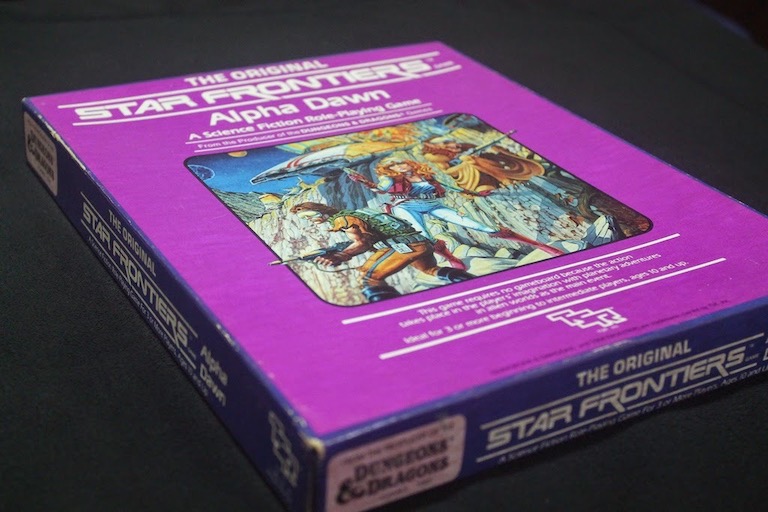
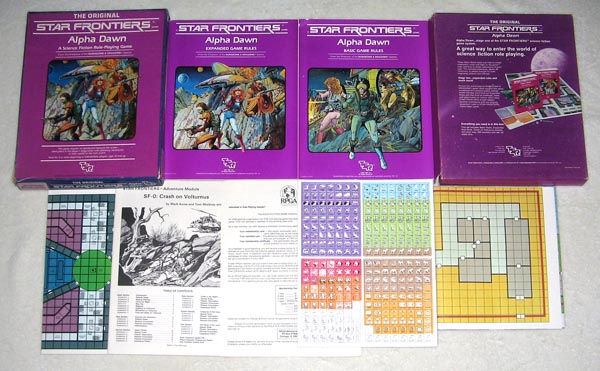

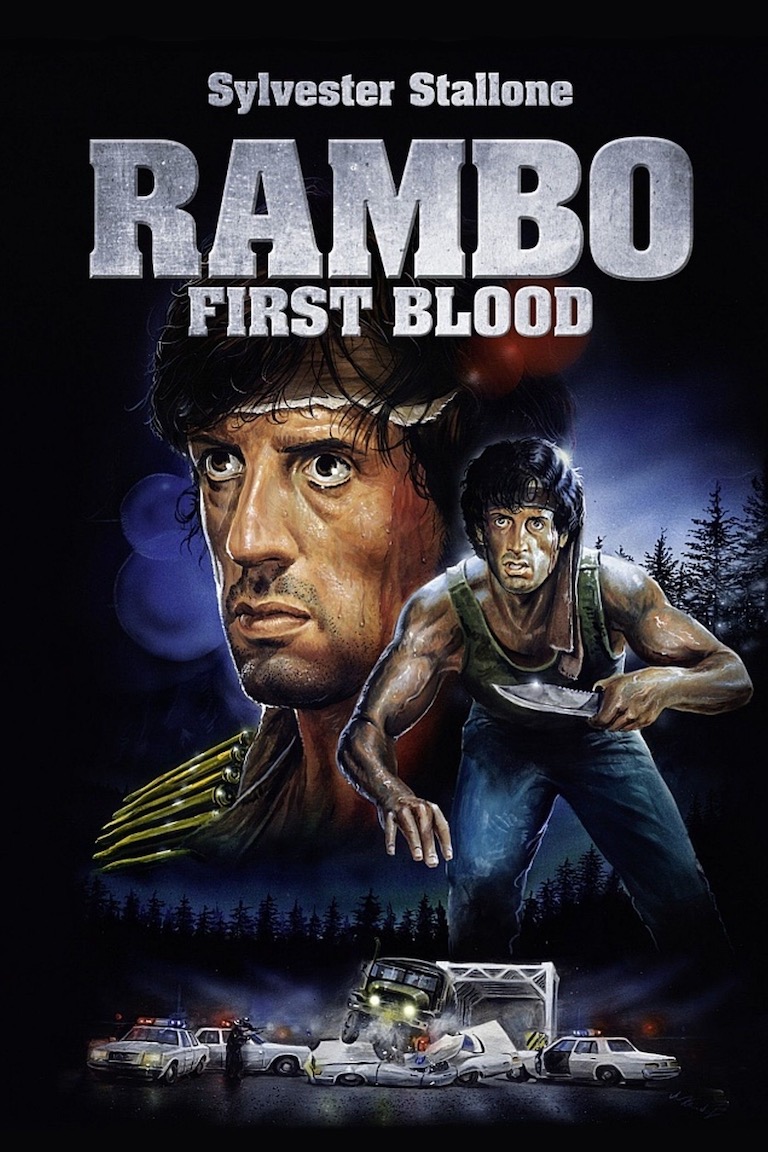
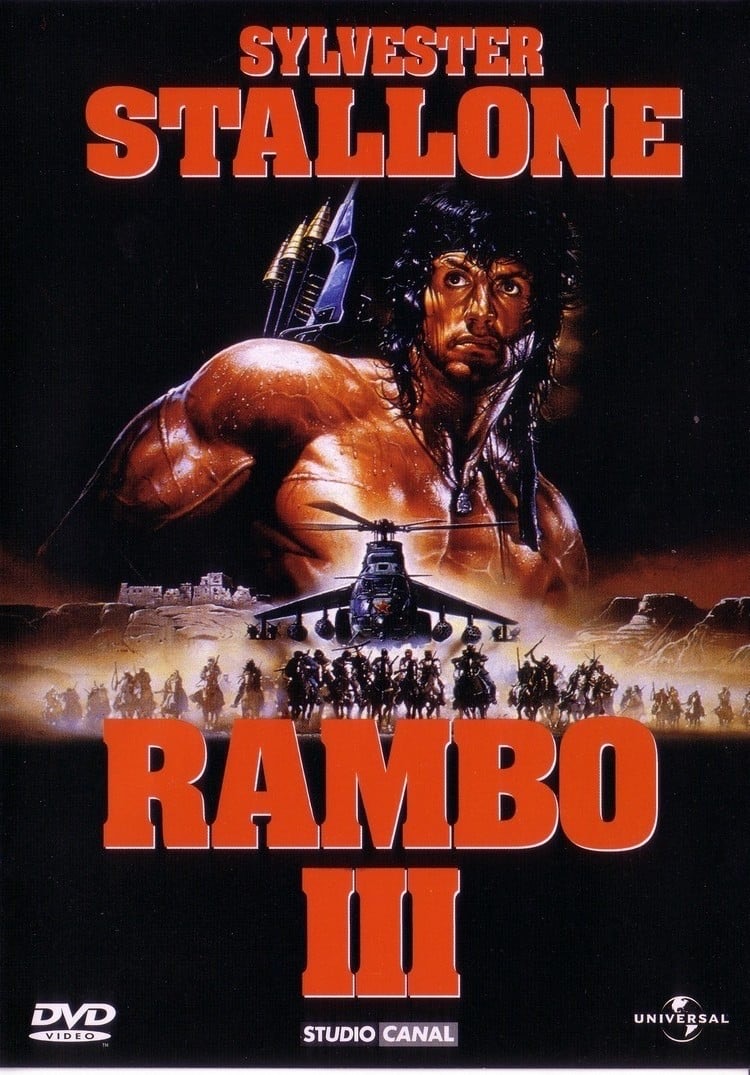
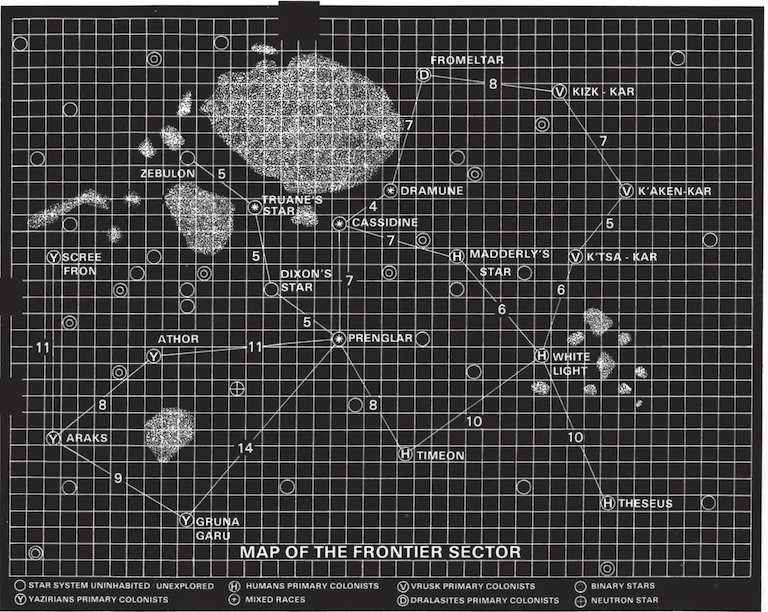
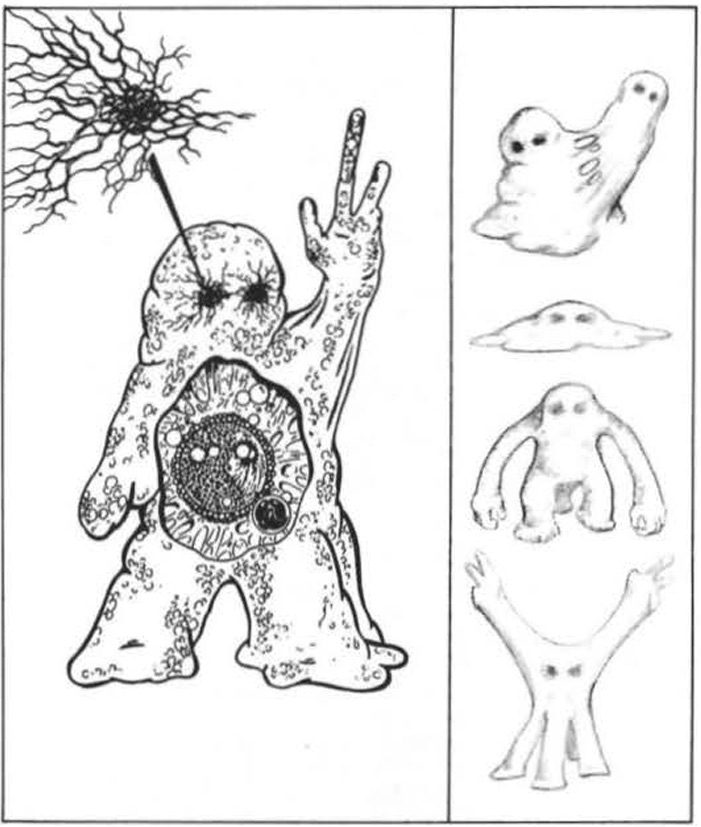

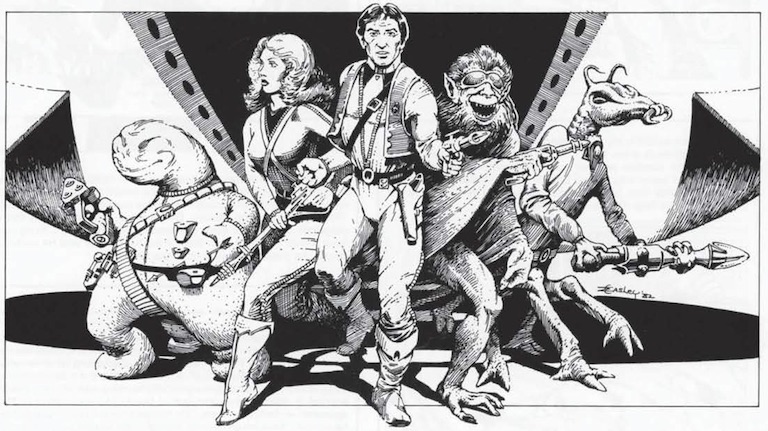

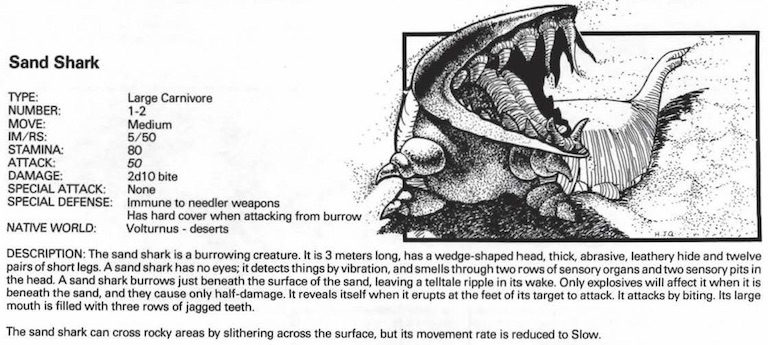
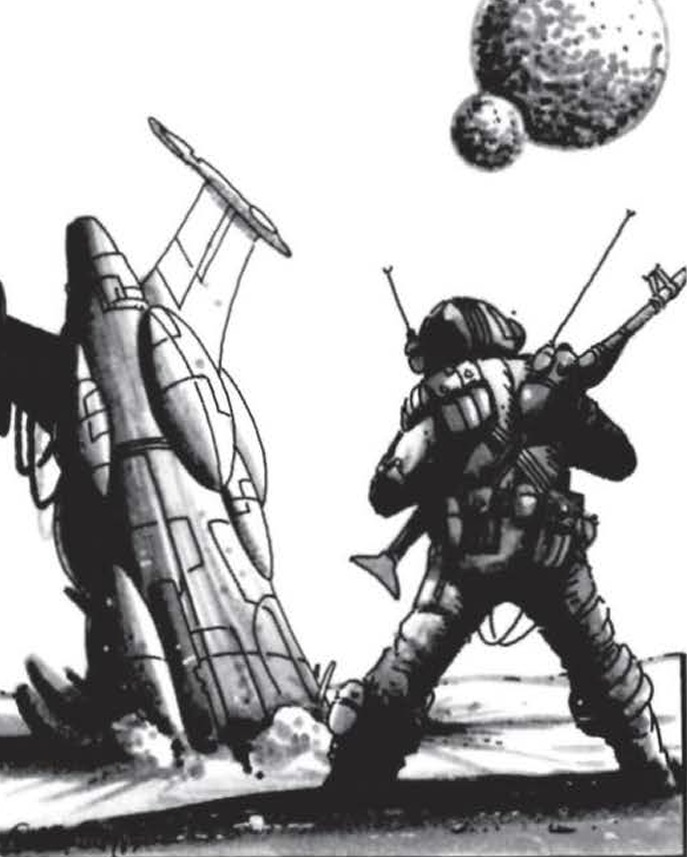
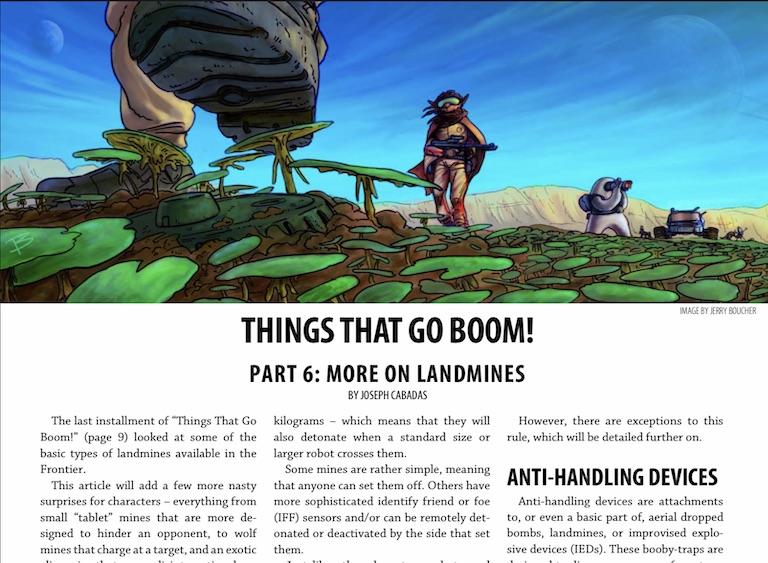
I am sorry that I never played Star Frontiers as the setting and the tone would seem to be a lot of fun. Unfortunately, the timing of its publication was all wrong for me: my gaming gang had been playing Traveller since 1977; I was trying to get a Universe campaign up and running; and the whole TSR-SPI bad faith loan arrangement soured me on any and all TSR items for years. Oh, well, maybe a con run will be in my future, if and when we have game conventions again.
I suspect once we’re all able to game together at cons again, you’ll find a few Star Frontiers games out there. I completely understand on the TSR-SPI causing a souring…I was oblivious to those at the time. 😉
Eugene,
I’m in a similar boat. I was spending all my gaming dollars on D&D when Star Frontiers came out, and I studiously ignored it. I regret that now… it eventually died due to lack of public interest, and that seems like a loss.
Hey… I sunk money into the Indiana Jones RPG…we all have regrets. 🙂
I had already dived into Traveller by the time Star Frontiers arrived. I never bought the actual game but I bought an adventure module “The Dramune Run”. We quickly adapted it to Traveller but Star Frontiers had a certain charm to it.
Thanks for commenting! Yes, it did have a charm to it that still resonates today, I think. It’s the ray-gun science fiction setting.
I enjoyed Star Frontiers when it came out, but most of my friends preferred Traveller for space RPGs. I was never a fan of the Star Frontier aliens or universe, which felt limited to me.
Another space RPG I enjoyed was Star Ace, from Pacesetter (which also published Chill and TimeMaster).
Hello! I always thought the aliens in Star Frontiers were a bit silly myself, but it seems right at home with the tone. My favorite aliens so far are those in 2300 AD, particularly the Kafers.
I’ve not heard of Star Ace. I’ll have to look that up! Thanks!
They used to have Star Frontiers ads in the back of certain Basic D&D books. I always like the look and idea of it, but never actually saw the physical game until years later, second hand. Doubt I will ever get a chance to play it which is a pity.
Hello! I may have to see if I can find some of those ads. The D&D ones were quiet…well…80s. 🙂 I do know folks who play Star Frontiers remotely, but it is definitely a challenge to find a game unless folks already play it.
Star Frontiers is still my favorite sci-fi trpg, even nearly 40 years later. Bought it when it first came out, and was actually the first box set I owned.
Haven’t played in forever. Still got my Alpha Dawn box set, but perhaps it’s time I ordered modern copies.
The hard copy (print on demand) from DriveThruRPG is very nice.
One summer (’83 I think) my friends and I went on a SF kick. We played a whole series of adventures on Volturnus. I think there were at least two adventure modules published, but we off on several different tangents. We never used the maps or counters that were provided. We were experienced RPGers. All we needed were our character sheets, our dice, and the rulebooks handy.
I never used the counters either. Theater of the mind! (I do use maps more these days.)
DrivethruRPG currently is offering the Star Fronters Referee’s Screen and the Star Frontiers Record Sheets for free.